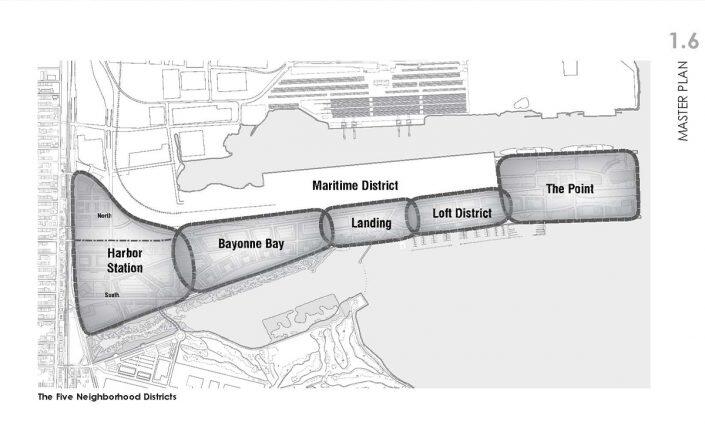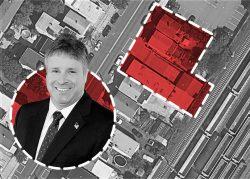The Peninsula at Bayonne Harbor was supposed to redefine New Jersey’s Gold Coast.
Developers envisioned a buzzing residential hub with retail, an accessible commute to Midtown and spectacular views of New York Harbor and the distant city skyline. They projected that 100 new buildings, including 7,000 apartments, would be completed within a decade.
That was in 2009.
Today, some completed developments dot the western edge of the peninsula, a two-mile pier on New York Harbor. But the bulk of it remains naked lots.
In late May, however, Bayonne’s planning commission approved a proposal that should kickstart a cornerstone development of the land.
New Brunswick-based Boraie Development got the green light to build the latest iteration of its plan. The firm will construct a 1,250-unit apartment complex with 10,000 square feet of retail along the peninsula’s waterfront.
Still, this was all supposed to happen years ago. Boraie, in fact, was first considered for a contract all the way back in 2006.
A smooth start
The peninsula’s development is a story of red tape, bad deals, fiscal fallout and power politics, but also of perseverance. It begins in the early aughts, when the future looked bright for this promising piece of Bayonne.
The city in 2001 had picked up the sleepy Military Ocean Terminal at Bayonne in a bid to transform it. Five years later, the Bayonne Local Redevelopment Authority was created to guide the overhaul of the terminal, renamed the Peninsula at Bayonne Harbor.
The Redevelopment Authority initially selected four firms to spearhead development of the pier’s six newly drawn subdivisions, NJTOD reported.

Military Ocean Terminal Bayonne diagram (NJTOD)
Fidelco Realty Group scored the redevelopment of Harbor Station, an area closest to the mainland that was supposed to get 800 new residences, plus retail, all within walking distance to the revamped Hudson-Bergen Light Rail with service to Jersey City.
Read more



Bayonne Bay Developers was chosen to build an eponymous neighborhood to Harbor Station’s east. The firm imagined Bayonne Bay as a thicket of 700 condos and 500 townhouses on the 25 acres of waterfront.
To Bayonne Bay’s East would be Boraie Development’s baby: the Landing District, an imagined meeting place with retail and entertainment, 600 residential units and a hotel — all offering views of New York Harbor. Taylor Real Estate Development also signed on to redevelop 12 acres of that section.
And Texas-based Trammell Crow Company was tapped to be first to break ground on the peninsula. The firm closed on 7 acres for $18 million in 2007 with plans to build a 544-unit luxury community, the New York Daily News reported.
Trammell wrapped up construction in two years and started leasing in June 2009. But for the other three developers, virtually nothing went as planned.
A secret deal
As Trammell built on the pier’s Western face, cracks began to form in the other development agreements.
In September 2007, the Redevelopment Authority went rogue, voting to sell off a slice of the peninsula to the Port Authority of New York and New Jersey without having warned the Bayonne City Council, according to the Hudson Reporter.
The authority claimed the $50 million sale would help close a city budget gap. But Bayonne, miffed by the backroom deal, threatened to dissolve the authority. Eventually the City Council persuaded the autonomous entity to push back a second vote on the sale to allow the council to consider other offers.
By Thanksgiving 2007, the Redevelopment Authority had struck a new deal for the same land, unloading it to Ports America for $40 million more than the Port Authority had offered.
Hours later, the Port Authority sued the redevelopment agency, claiming breach of contract, American Shipper reported, and throwing a wrench in the city’s financing options.
That would be the first of at least five lawsuits to stymie the project’s progress.
Things get complicated
In the meantime, Bayonne’s fiscal situation grew more dire.
In the wake of the Great Recession, the city was on the verge of bankruptcy, facing a $33 million deficit and the threat that the state would seize control of its finances, the New York Times reported.
But New Jersey was grappling with its own fiscal crisis. Assuming Bayonne’s financial deficit would have come with a multi-million-dollar price tag, according to the Times.
Meanwhile, the Redevelopment Authority found itself in hot water with the U.S. Army. In breach of its initial agreement, the agency had funneled proceeds from peninsula land sales into the city budget. (The city had agreed to reinvest proceeds from selling or leasing the land back into the property for at least seven years.)
The army claimed authority had misassigned $55 million.
By 2010, Bayonne had reached a tipping point. If it didn’t fill a $20 million gap in its budget that summer, the state would take over its finances.
The Port Authority, which governors of New York and New Jersey sometimes use to do their bidding, offered a way out for the city and a less costly solution for the state.
In March, Bayonne’s then-Mayor Mark Smith directed the redevelopment entity to see if the Port Authority might want a new opportunity to purchase, the Times reported. To bolster relations with the city, the Port Authority had dropped its lawsuit.
After some negotiations, the parties settled on a $235 million sale that would turn over much of the peninsula’s eastern half to the Port Authority. The groups signed the contract on July 30, the same day as the state takeover deadline.
Four days later the Port Authority handed over $40 million, which the redevelopment authority passed along to Bayonne, according to the Times.
Cue the lawyers
But if the Port Authority deal provided a lifeline to Bayonne, it also sank the city’s dreams for a peninsula-long development: The acquisition handed over 130 acres — about one-third of the targeted area — to the bi-state transportation agency.
Compounding matters, a series of lawsuits launched by contracted developers had stymied construction on the pier’s West side.
Fidelco Realty, enlisted to build hundreds of for-sale homes, sued the Redevelopment Authority in August 2009 to get more time to begin construction and the flexibility to build rentals, given the nationwide housing collapse, according to the Hudson Reporter.
The authority orchestrated a settlement where Fidelco would reassign its redevelopment rights to developer Robert Mazzuocola, who would use the space to build hotels and retail.
But that deal fell through on March 30, 2010, after Fidelco learned that Mazzuocola hoped to use the space for maritime use, which was disallowed by the commercial redevelopment plan, the Hudson Reporter wrote.
Adding insult to injury, Fidelco discovered redevelopment agency’s plans to sell off three of the pier’s districts to the Port Authority after the Mazzuocola deal dissolved. The firm claimed truck traffic from the Port Authority’s operations would make it impossible to develop high-end residential. Fidelco promptly sued again.
Trammell Crow Residential and Bayonne Bay Developers piled on with their own suits, claiming that the Port Authority sale adversely affected their property values and development rights, NJ.com reported.
The cases would delay development for at least three more years, according to NJ.com.
As if the Redevelopment Authority’s lawsuits weren’t enough of a headache, in 2013 the city of Bayonne discovered the agency had amassed a mountain of debt.
Making good on prior threats, Bayonne dissolved the authority and issued a $75 million bond to pay down its deficit, NJ.com reported.
A few steps forward…
With the agency out of the way and the economy improving, the city made a concerted effort to kick the peninsula plan into gear.
Bayonne settled the Fidelco suit in 2014 by giving the developer a 30-year tax abatement. It reached an agreement with Trammell Crow by removing a minimum payment requirement the developer had agreed to in lieu of taxes.
And in March 2015, the city settled with Bayonne Bay Developers in a deal that allowed the firm to buy 20 additional acres for $1.16 million, Hudson County View reported.
With those lawsuits gone, the city revamped its redevelopment plan. It proposed a less ambitious 2,500 residential units, plus a hotel and offices.
Fidelco would break ground first in the spring of 2016 on a 400-unit residential building in Harbor Station North. A second phase would bring the project to 850 units.
Atlantic Realty would then put up 525 garden apartments in Bayonne Bay West, the neighborhood catty corner to Harbor Station North. Those would arrive in the summer of 2016.
By spring 2017, Kate Howard LTD would begin construction on a 300-room hotel, 450 units of townhouses and an outdoor retail center, according to NJ.com.
And that same season, Boraie Development would kick off a 600-unit development in Bayonne Bay East.
Sharon Ashe-Nadrowski, Bayonne’s City Council president, said apart from some reshuffling of ownership — Kate Howard was ultimately dropped — or minor tweaks to plans, construction on the Peninsula progressed relatively untroubled from that point.
Kushner Real Estate Group took over Fidelco Realty’s redevelopment rights. KRE Group did not respond to a request for comment and Fidelco could not be reached on why that land was reassigned.
KRE Group has since completed and leased the first and second phases of Bay 151, the project formerly named Harbor Station North. A third phase of the project is expected to bring the unit count to 625, New York Yimby reported.
And although the pandemic created delays, developers have pushed through.
Atlantic Realty, for example, opened 290 units of Bayonne Bay in January 2021, nearly two years after the projected completion date. The firm, which did not respond to a request for comment, is expected to produce another 210 units.
“Overall, everything was really smooth,” Ashe-Nadrowski said. “There were really no issues down there.”
One step back
The sole exception, the City Council president said, was the development planned by Boraie.
Ashe-Nadrowski said after the city awarded the group rights to the land in 2015, it did not draw down its loans or take ownership of the property. The firm locked in a $35 million sale price but never paid the city. In the years since, Ashe-Nadrowski claims the land’s value has more than doubled.
“[The developer] made $60 million just by sitting there holding onto the land and the city got nothing,” she said.
Ashe-Nadrowski pushed back against the low sale price, criticizing Bayonne Mayor James Davis for giving a “sweetheart deal” to one of his donors: Boraie Development’s Vice President Wasseem Boraie, the eldest son of the firm’s founder.
Boraie Development did not return a request for comment.
A spokesperson for the mayor defended Davis, telling the Hudson Reporter that if the city reneged on the deal it could open itself up to “significant legal costs and exposure.”
Ashe-Nadrowski was Davis’ main challenger in the Bayonne mayoral race, in which Davis secured re-election last month.
The mayor won the Boraie battle, too. In mid-May, the City Council granted final site approval for phase one of Boraie’s revised project and preliminary approval for the next two phases.
In total, the five-building proposal will deliver 1,250 units, 10,000 square feet of retail, and parking garages featuring rooftop terraces and pools.
Davis’ spokesperson told the Hudson Reporter in March that after a seven-year delay, the project would be able to begin construction “immediately after receiving final site plan approval.”
A groundbreaking date has yet to be announced.
